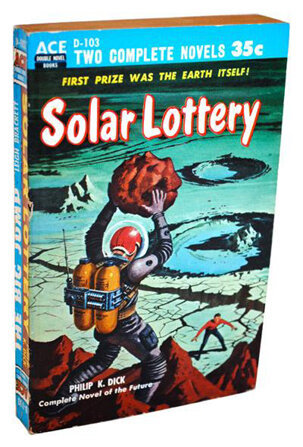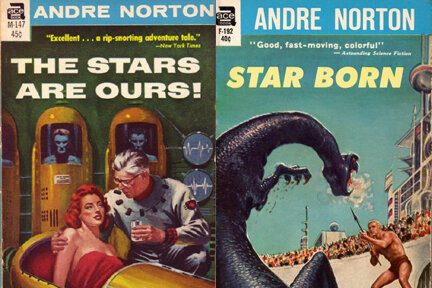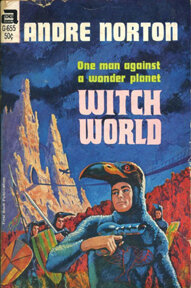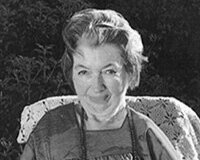Dan Lutts's Blog, page 3
June 17, 2021
Andre Norton
When I was in junior and senior high school in the late ‘50s and early ‘60s, I read a lot of science fiction novels. Most of the books were Ace paperbacks that I bought from the spinner rack at Lincoln Pharmacy, the local drugstore. The Ace paperbacks came as singles and doubles. The singles contained one novel and the doubles contained two novels. The doubles novels had one story’s cover on the front and the other story’s cover on the back. The spine displayed both titles. You would read the first novel, then flip the book over and read the second. I discovered Andre Norton’s novels in the drug store as Ace paperbacks and fell in love with her stories.

Ace Doubles Paperback
Like Rosemary Sutcliff, Alice Mary Norton was a remarkable woman who battled ill health for most of her life. Born in Cleveland, Ohio, in 1912, she dropped out of college because of the Great Depression, which altered so many people’s lives and crushed their ambitions. She ended up working in the Cleveland Public Library. When she was 22, she published her first novel. Back then, editors discriminated against women writers. So later that same year Norton legally changed her name from Alice Norton to Andre Norton. She figured that editors and readers would consider a novelist named Andre to be either male or female.
Norton published in several genres, including historical fiction and romance. In 1947, she turned to science fiction by publishing her first science fiction short story, “The People of the Crater,” in Fantasy Book Magazine in 1947. Her big break came in 1952 when she published her first science fiction novel, Starman’s Son, 2250 AD, which science fiction readers scoffed up. She continued writing science fiction. Some of my favorites are The Stars Are Ours, Star Born, Time Traders, and Voodoo Planet.

Back then, though, mostly boys read science fiction because the themes were mostly male oriented. Norton eventually thought that girls should be able to read it, too, and set out to write a series whose stories would appeal to them. The result was Witch World, which became widely popular with girls. The series also became her most popular one.

Norton won many awards for her science fiction writing, including the Gandalf Grand Master of Fantasy award—the first woman to ever receive it.
Unfortunately, Norton’s ill health eventually prevented her from writing, and she died in 2005 from congestive heart failure. She requested not to be buried, but to be cremated—along with the first and last books she wrote, The Prince Commands (1922) and Three Hands of Scorpio (2005).
Andre Norton still has plenty of fans today, and I’m one of them.
February 15, 2021
Some YA Books to Help You Pass the Time
With COVID-19 still with us, more and more people have turned to reading books to pass the time and help them cope. Many people are reading the really popular novels by authors like Cinda Williams Chima, J.R.R. Tolkien, Rick Riordan, and John Flanagan. Yet there are a lot of other authors who might not be as well known or whose books aren’t as readily available you might be interested in reading. Here are three novels I particularly enjoyed.
The Eagle of the Ninth
Rosemary Sutcliff’s The Eagle of the Ninth is the first in a three-part series that takes place in Roman Britain. The plot is based on both fact and conjecture. The Ninthth Legion actually existed. It was formed sometime before 89 B.C. and fought under Julius Caesar. In 43 A.D. the Ninth was sent to Britannia. But here’s the mystery: All mention of the legion and its 5,000 legionaries suddenly stopped in the early 2nd century. Historians still debate the legion’s fate.
In The Eagle of the Ninth, Sutcliff uses the legion’s disappearance to get the plot rolling. Marcus Flavius Aquila, who was a centurion serving in Britannia during the 2nd century, was discharged because of a battle wound. His father served in the Ninth, and Marcus always wondered what happened to both his father and the legion. So, posing as a Greek eye doctor, he and a former slave go beyond the safety of Hadrian’s wall in search of the answer.
The Eagle of the Ninth is the first part of a three-book, intergenerational series that uses the Ninth’s eagle to connect the stories. The other books in the series are The Silver Branch and The Lantern Bearers.
Rosemary Sutcliff (1920-1992) was a remarkable woman. As a child, she came down with Still’s disease, a debilitating, rheumatic childhood disease, and was confined to a wheelchair for most of her life. She also was in constant pain. Sutcliff learned how to read when she was nine. She also didn’t receive much formal schooling because her father, who was in the navy, moved around a lot. Her mother, though, read to her and told her stories about the Greeks and Romans, Anglo-Saxons, King Arthur, and other historical topics. When she was fourteen, Sutcliff enrolled at the Bideford Art School, where she learned miniature painting, which she used to make a living. Later, she turned to writing, and used her mother’s stories for inspiration. I think we all benefited from the her career change.

Rosemary Sutcliff
Bloody Jack: Being an Account of the Curious Adventures of Mary “Jacky” Faber, Ship’s Boy
L.A. Meyer’s Bloody Jack is a lot of fun to read. It begins in London, England, when Mary Farber’s parents and siblings die from disease and she is forced to live in the street. To survive, she joins a gang of homeless children who live under the Blackfriars Bridge. Later, she disguises herself as a boy and joins the crew onboard the Dolphin, a British man of war. She’s always on tender hooks because she’s afraid her disguise will be blown. Her adventures are hilarious—and some highly improbable—which only adds to the fun. Don’t expect strict adherence to historical detail, though. But that’s no big deal in this series.
Bloody Jack is part of an eleven-book series. The books take you all over the place, including America and France. In the sixth book, My Bonny Light Horseman, Jackie is forced to work undercover for the British as one of Napoleon Bonaparte’s soldiers. (It’s either cooperate or be executed as a pirate.)
On a sad note: Meyer knew he was dying. So he made sure the last book he would write, Wild Rover No More, would be plotted to end the series.
The Medici Seal
Theresa Breslin’s The Medici Seal takes place in Renaissance Italy in 1502. This is the period during the Italian Renaissance where city states are fighting one another for dominion. The Medici rule in Florence and the infamous Pope Alexander VI and his even more infamous son, Cesare Borgia, are extending their power over Italy for both themselves and the papacy.
Young Matteo is fleeing from Sandino, a ruthless outlaw who wants to take something Matteo has. In fact, the object is so important that if the Borgias or the Medici learn that he has it, they will kill him for it. That’s not a good situation to be in. Matteo finds temporary refuge with the dell’Orte family, but eventually continues his flight until he encounters the famous Renaissance artist Leonardo da Vinci. Da Vinci takes Matteo into his household. In spite of the safety of being with da Vinci, Matteo must be extra careful because da Vinci’s patron is Cesare Borgia. And if Borgia should learn about the object, not even da Vinci could protecte Matteo. One day Matteo learns that Sandino has been tracking him and the dell’Orte family. Now Matteo must decide whether to risk both his safety and his life to warn the dell’Ortes or remain with da Vinci and let the dell’Ortes be killed.
Theresa Breslin is a popular Scottish author who has written over fifty novels in varying genres for a wide audience, from children to adults.



